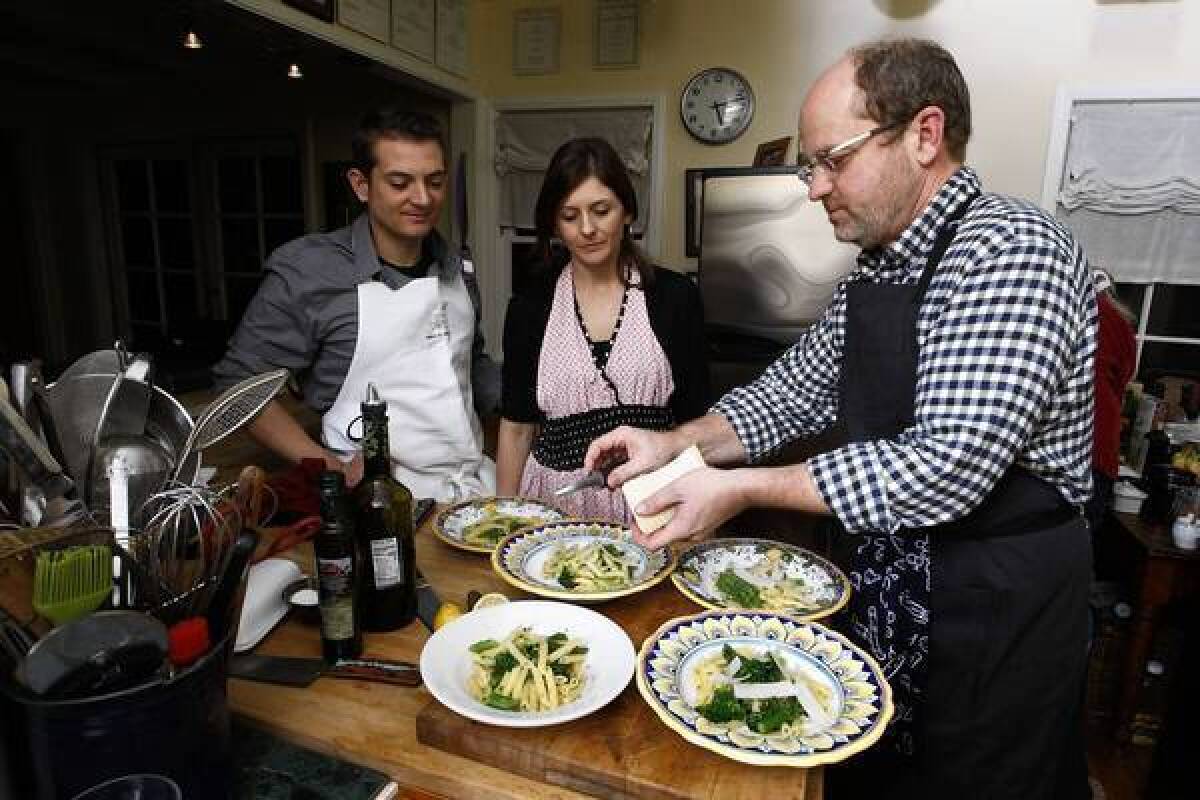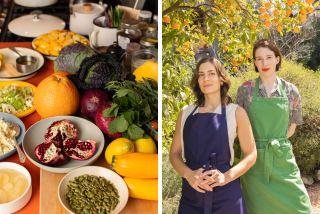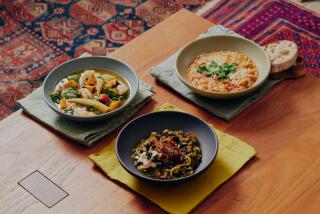The California Cook: Basic dishes a couple can build on

Meghan and Carter are getting married. Like so many friends of my daughter, they are bright, funny and, sometimes, almost preternaturally serious. A couple of weeks ago, they asked my wife if we would talk to them about how to stay married — and about how to cook.
The first, I’ll leave to Kathy; after almost 34 years, it’s still a mystery to me. But the cooking part is right up my alley, and, even better, I figured it would give me a chance to try out some of the ideas I’ve been on a soapbox about for the last couple of years.
A basic knowledge of cooking — not the intricacies of fancy restaurant dishes or the parsing of various ethnic cuisines — seems to me to be fundamental to a happy life, whatever your relationship status. A good meal gives such great joy, why would you want to leave it to the hands of a stranger?
So Sunday night, Meghan and Carter came to the house for a cooking class. But instead of doing the usual thing and walking them through a couple of recipes, I wanted to try something different. I love recipes as much as the next guy, but it does seem to me that they are an imperfect way to learn to cook. Sure, a well-written recipe can teach you how to re-create a specific dish, but that’s a different thing from actually knowing how to cook, isn’t it?
What I wanted to try out was more along the lines of teaching the structure of a dish, how it is put together. Rather than the details of a recipe (1/2 teaspoon of this, 1/4 cup of that), I wanted to see if I could teach them to prepare a dish by explaining its general outline, allowing for (even encouraging) the kind of freedom to experiment and personalize we all want to enjoy when we cook.
Instead of teaching them to make Marcella Hazan’s roast chicken stuffed with lemon (a wonderful recipe, by the way), could I teach them how to roast a chicken — the broad outline, the key points and how to think about the various possibilities?
If I could do that, they would learn dozens of dishes rather than just one.
Besides roast chicken, it seemed to me that if I could do the same with a couple of other very basic dishes — a simple salad and a vegetable pasta — they would have enough to cover almost any mealtime eventuality, from a weekend dinner party to a quick bite after a long day at work.
We started with the chicken, because it would take the longest to cook. (Lesson No. 1: You rarely prepare one dish straight through; think about how to organize your time so you can stay busy. And Lesson No. 2: Clean up after yourself as you go along.)
In the bottom of the roasting pan, we scattered fennel and onion we’d cut into wedges, which allowed some basic hints on how to hold a knife and how to use it carefully to avoid cutting off fingertips. Of course, we could have used potatoes or other root vegetables instead — same technique but a slightly different result.
Later on, I showed them how to judge by look and feel when a chicken is done (and how to use an instant-read thermometer to be sure), and a basic poultry anatomy lesson (in other words, how to carve).
The vegetable pasta is so simple and quick you can prepare the whole thing in the time it takes the noodles to cook. But it’s also incredibly flexible. We made it with broccoli rabe, but it could just as easily be made with broccoli or cauliflower, or with cooking greens (chop them small and add them just for the last couple of minutes).
We made the simplest sauce — just olive oil, red pepper flakes and whole browned garlic cloves — but it could have been made with sliced garlic and capers, or with Italian sausage or pancetta browned in the oil, or with sun-dried tomatoes or slivered prosciutto added after. Instead of Parmesan we could have used pecorino Romano.
That makes dozens of possible dinners, all of which can be prepared in less than 30 minutes.
But maybe the most interesting of the dishes we made was the most basic — a green salad. We started by going out to my garden and tasting different greens, some sweet and soft, others bitter and crisp. “Lettuce” isn’t just “lettuce.” We rubbed a cut clove of garlic around the bowl to get the scent but not the harshness.
Then we moved on to the vinaigrette. Using lettuce leaves as tasters and starting with a quarter-cup of olive oil, I added sherry vinegar a little at a time until we decided we had the right balance (a little less than the classic 3-to-1 oil-to-vinegar ratio). Then I added a bit of salt, to demonstrate how that brought out more flavors. I added a squeeze of lemon — just a teaspoon made a big difference in the taste.
And finally, I had them toss the salad with their hands, adding the vinaigrette just a little at a time, so they could appreciate how little dressing it takes. We needed less than two tablespoons of vinaigrette to lightly coat and flavor a half-pound of greens.
Just as it was, the salad was delicious, but we wanted to make it a little different, so Meghan scattered red grapefruit segments over the top, and then Carter did the same with chopped pitted Medjool dates.
A couple of hours, three basic ideas and hundreds of delicious possibilities. Let’s hope everything in their marriage will be that easy.
More to Read
Eat your way across L.A.
Get our weekly Tasting Notes newsletter for reviews, news and more.
You may occasionally receive promotional content from the Los Angeles Times.











